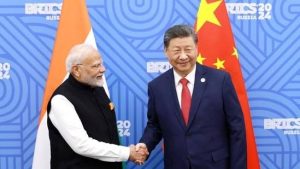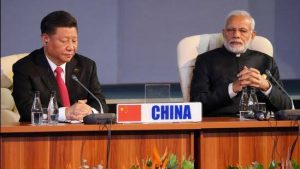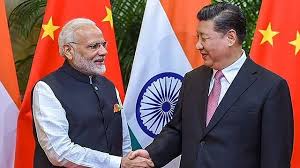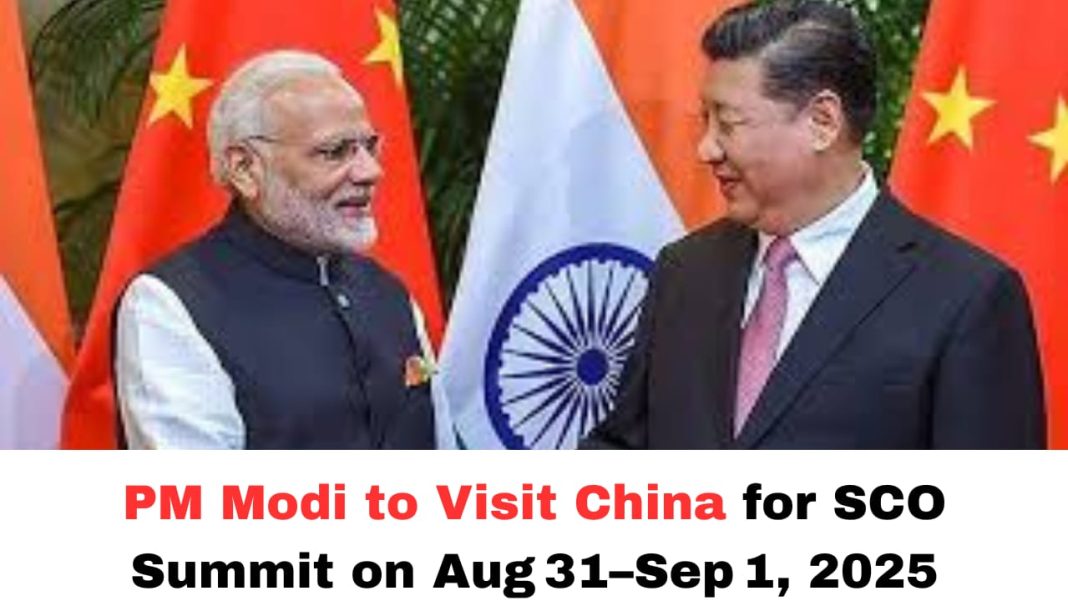Digital News Guru National Desk:
Modi’s Return to China after Seven Years: A Diplomatic Pivot Amid Geopolitical Tensions
Prime Minister Narendra Modi is set to travel to Tianjin, China, from August 31 to September 1, 2025, to attend the 25th Shanghai Cooperation Organisation (SCO) Summit. This visit marks Modi’s first trip to China since 2018, and his first since the June 2020 Galwan Valley clashes, which dramatically strained India–China relations.
A Summit Against a Shifting Geopolitical Backdrop
The SCO is a major Eurasian security and economic grouping that includes Russia, Pakistan, Iran, and major Central Asian states. The Tianjin summit, China’s fifth time hosting, comes amid rising regional complexities—including heightened India–U.S. trade tensions, and ongoing SCO disagreements over terrorism and diplomatic messaging.

Why Now? A Calculated Diplomatic Reset
- Border De‑Escalation and Mechanism Revival
Since the 2020 standoff along the Line of Actual Control (LAC), the two countries have initiated a phased confidence-enhancing process. In October 2024, Modi and Xi Jinping held talks in Kazan, Russia, leading to troop disengagement at key friction points. In January 2025, India resumed direct flights with China, and in July 2025, it resumed the Kailash Mansarovar Yatra and reinstated tourist visas for Chinese citizens after a five‑year break. - Normalization of Relations and People-to-People Ties
These measures reflect a broader shift toward normalizing bilateral ties through tourism, travel, and diplomatic channels—significant after years of lockdown in relations, trade, and exchanges. - United States Tensions and Strategic Recalibration
Modi’s visit occurs at a time when India–U.S. trade relations face heightened tensions—most notably, through increased tariffs on Indian exports and pressure over India’s import of Russian oil. This broader strategic environment may be prompting India to seek regional balance through engagement with.
Preparing the Ground: High-Level Preliminaries
India and China have held multiple ministerial exchanges in early 2025:
- In June 2025, Defence Minister Rajnath Singh attended the SCO Defence Ministers’ meeting in Qingdao and refused to sign a joint statement that excluded any mention of the Pahalgam terror attack and instead referenced Balochistan, which India viewed as politically biased.
- In May–July 2025, Foreign Minister S. Jaishankar participated in SCO Foreign Ministers’ meetings in Tianjin to reinforce diplomatic momentum.
- The National Security Adviser, Ajit Doval, has been in Russia to discuss oil purchases and defence ties, especially relating to pending arms deliveries like the S‑400 air defence system, complementing India’s careful positioning between global.
In Summit Focus: Key Themes and Expected Outcomes
The SCO Summit itself is expected to deliberate on multiple pressing issues:
- Terrorism and Security: India has voiced strong objections within the SCO to attempts to dilute references to terrorism, especially regarding the Pahalgam attack. Ahead of the summit, India hopes for tighter language and greater clarity on shared threats from cross-border terror networks.

- Energy and Trade Dynamics: With the U.S. threatening further sanctions over India’s Russian oil imports, the SCO platform may offer India opportunities to explore alternative energy ties among member states and reaffirm strategic autonomy.
- Border Diplomacy and Regional Stability: While recent border disengagement has reduced immediate friction, both sides still maintain sizable troop deployments along the LAC. Modi may press for a roadmap toward de‑induction and formal dialogue mechanisms to prevent flare-ups.
- Bilateral Talks with China: On the sidelines, Modi is expected to meet with Xi Jinping—their first face-to-face engagement since October 2024—which could explore further de-escalation, expansion of economic ties, and revival of stalled initiatives like cultural cooperation, transport links, and border-trade points.
Significance of the Visit: A Broader Geopolitical Message
- Diplomatic Thaw: After nearly seven turbulent years since their last high-level visits, this trip signals a deliberate thaw in India–China relations, as both sides show cautious intent to reset ties on a structured footing.
- Geostrategic Rebalancing: With U.S.-India economic friction rising, India appears intent on diversifying alignments—strengthening engagement with regional groupings like the SCO while maintaining openness to global partners.
- SCO as a Platform for Critical Dialogue: The summit provides India a structured environment to press for recognition of terrorism threats, shape regional security narratives, and rebalance influence within the Eurasian sphere.
Potential Risks and Challenges Ahead
Despite positive momentum, several potential risks remain:
- Trust Deficit Remains: The lingering memory of the 2020 Galwan clashes continues to shape Indian domestic sentiment and strategic caution toward China. Public skepticism may persist unless tangible progress is achieved on trust-building.
- Domestic Political Sensitivities: India’s firm posture on terrorism and border issues may clash with China-backed narratives within SCO, including references to Balochistan or softening language on terror-related topics.
- Economic Asymmetries: While summits focus on diplomacy, underlying economic disparities and protectionist pressures persist—particularly amid India’s concerns on rare earth exports regulations and trade barriers.
Looking Ahead: What to Watch During and After the Summit
- Will there be a joint statement with India‑specific references to terrorism or border concerns, or will diplomatic friction endure?

- Are there any new frameworks for people-to-people exchanges, including new travel corridors, ease of visas, or enhanced business cooperation?
- Could Modi and Xi agree on further steps toward troop disengagement or formal border management mechanisms?
- What messaging emerges on Indian energy independence, possibly looking beyond Russia amid U.S. pressure?
Conclusion
Prime Minister Modi’s visit to China from August 31 to September 1, 2025, at the Tianjin SCO Summit, represents a calculated diplomatic reset, not merely a multilateral engagement. As third-party tensions—especially with the United States over trade and energy—escalate, India appears to be seeking equilibriums in global alignments. While the trip holds promise for deeper dialogue and regional cooperation, its success hinges on how both sides address longstanding trust deficits and pressing security concerns.
You May Also Read: U.S. Doubles Tariffs on Indian Imports to 50%








